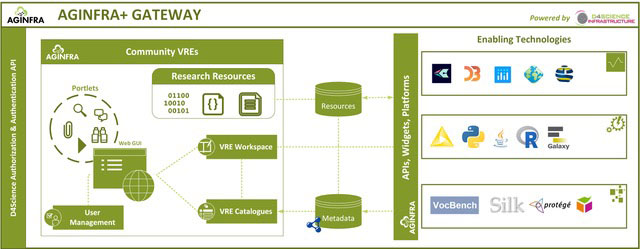by Panagiotis Zervas, Leonardo Candela and Pythagoras Karampiperis (Agroknow)
Virtual research environments are proposed as a prominent cloud-based solution for agricultural and food scientists willing to collaborate and seamlessly access, use and reuse research resources such as datasets, mathematical models, software components results and publications.
Current developments in ICT potentially provide innovative and more effective ways to support agricultural and food researchers to work with extremely large data sets and handle use cases involving big data. This new paradigm raises new research questions, new methods and approaches to perform research in agriculture and food. To support this paradigm, research facilities and e-infrastructures need to be revisited and new partnerships among academic institutions and private companies should be developed. This might lead to the involvement of scientists from areas of science and technology, who are not involved in the agricultural and food sector, to boost the innovation process in this sector. This also creates new challenges and opportunities for informed decision making from the micro scale (i.e., precision farming) to the macro scale (i.e., policy making) [1]. To this end, it is evident that large-scale, cloud-based infrastructure assets need to be utilised to support the agriculture and food research communities in the process of data storage and indexing, algorithm execution, as well as results visualisation and deployment.
A prominent existing cloud-based solution is the Virtual Research Environments (VREs) provided by the D4Science Initiative. VREs are web-based, community-oriented, collaborative, user-friendly, open-science-compliant working environments for scientists and practitioners working together on a research task [2].
In this context, the AGINFRA+ project [L1] is exploiting the VREs paradigm for three (3) prominent research communities, namely:
- The agro-climatic and economic modelling research community: this community focuses use cases related to crop modelling and crop phenology estimation. Current cases aim to support the workflow of researchers, intermediaries and business analysts working on crop modelling and yield forecasting and related activities in the area of policy and decision support in food security, farm management advice and related activities. In particular, the aim of these use cases is to bring researchers from their current usually local, single computer and mostly peer network based work space to a cluster compute and cloud based collaborative work environment. Providing the community with such advanced options for virtual research will increase the buy-in to use such frameworks and support the community in making the transition to effective collaborative, cloud-based research.
- Food safety risk assessment research community: this community focuses on use cases to support scientists in the multidisciplinary field of risk assessment and emerging risk identification as there is currently a strong need to create new software-based solutions that support the knowledge integration processes relevant for these tasks. Domain-specific, cloud-based research environments are a promising solution to overcome current limitations and frustrations in these domains. Specifically, features that facilitate scientific collaboration as well as features to store and share data and knowledge are important. Furthermore, the usage of broader infrastructural and technical solutions can facilitate the creation and adoption of standards which will increase efficiency along all scientific processes.
- Food security research community: this community focuses on use cases related to high-throughput phenotyping to support phenomics researchers to select plant species and varieties which are the most adapted to specific environments and to global changes. High-throughput phenotyping produces a large amount of data which need to be analysed immediately for decision making, as a result cloud-based research environments are a promising solution to support this process.

Figure 1: AGINFRA+ Technical Infrastructure based on research community VREs.
In order to support the aforementioned research communities, AGINFRA+ project has collected requirements from these communities and appropriate VREs have been set-up [L2]. These VREs encapsulate the technical solutions serving the community requirements within a collaborative environment that allows the setup, execution, monitoring and sharing of research activities and their results. More specifically, as presented in Figure 1, the VREs provide researchers access to research resources such as data, models and publications, in order to design and execute their research. The resources are findable via the VREs’ Catalogues, which are informed by semantically rich metadata organised and generated using the AGINFRA+ Data & Semantics Layer technologies. Experiments are carried out via the execution of the available models over the services provided by the Analytics & Processing Layer. Finally, results are visualised, organised and shared using the technologies incorporated in the AGINFRA+ Visualisation & Publishing Layer.
In summary, the aforementioned approach aims to serve the needs of three adjacent but not fully connected user communities, which perform research on multi-disciplinary and multi-domain problems related to agriculture and food. Finally, it aims to support open science to research resources for agriculture and food.
Links:
[L1] http://www.plus.aginfra.eu/
[L2] https://aginfra.d4science.org/explore
References:
[1] S. Wolfert, L. Ge, C. Verdouw, M-J. Bogaardt: “Big Data in Smart Farming – A review”. Agricultural Systems, Vol. 153, pp. 69–80, 2017 10.1016/j.agsy.2017.01.023
[2] L. Candela, D. Castelli, P. Pagano: “Virtual Research Environments: An Overview and a Research Agenda” Data Science Journal. vol. 12, pp. GRDI75–GRDI81, 2013 10.2481/dsj.GRDI-013
Please contact:
Panagiotis Zervas
Agroknow - Athens, Greece
+302106897905











